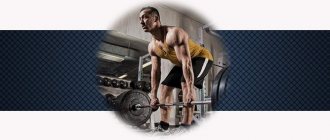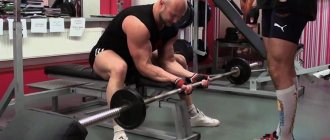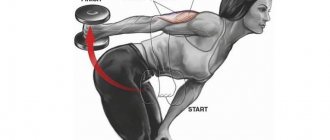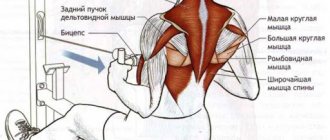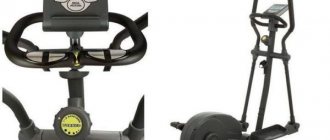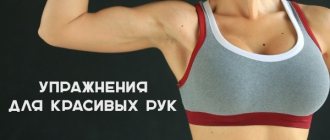What is a deadlift
Let's start with the main thing. Especially for beginners, we will answer what a deadlift is .
The deadlift, in its physical and mechanical content, is the only movement in which we need to lift the barbell from the floor with our backs. When performing this exercise, the largest number of muscles in the body are involved, including the muscles of the legs, arms, back, and even the core.
Hence, the attitude towards it often resembles the position that, they say, it is not so important to improve the technique and you can lift a lot with your “naked” back. But this is the same as performing the movement without using a special form. For this purpose, the most rational and effective technique in each movement is determined in order to direct the “naked” force in the right direction to significantly increase the result.
Types of deadlifts: classic, sumo and Romanian deadlifts
How to perform a deadlift
There are three types of deadlift : classic and sumo style. There is also a women's version of the deadlift, the Romanian deadlift. It must be said right away that the “sumo” style is more advantageous for using all the strength an athlete has. Despite the fact that the body structure of people differs, practice shows that in any case, with good development of the movement technique, the effectiveness of the “sumo” style is undoubtedly higher. What is the technique for optimally performing sumo-style deadlifts?
Execution technique
Knowing what the deadlift does, you can move on to the execution technique. It plays an important role, as, in fact, in any other training. Proper execution not only helps you achieve high results, but also reduces the risk of injury. Since you are working with heavy weights here, you need to be extremely careful, otherwise there is a risk of injury.
How to take the starting position using the example of working with a barbell:
- We get close to the bar.
- Feet are shoulder-width apart, strictly parallel to each other, with toes protruding beyond the bar.
- The back is kept straight, only the shoulder blades bend. The neck should also be straight, causing the eyes to look towards the ceiling.
- The legs bend at the knees, the back remains straight.
- We clasp the bar with our hands, placing them slightly wider than shoulder width.
Direct weight lifting:
- Before lifting the barbell, the athlete takes a deep breath.
- At the moment of exhalation, you need to lift the barbell, feeling how the torso and legs take a straight position.
- The lowering process should be exactly the same, with the bar remaining parallel to the floor. The back is flat, the shoulder blades are brought together.
- Only when the bar has crossed the level of the knees can you begin to squat, at this moment the pancakes already touch the floor.
Speaking about specific numbers, one approach can include from 4 to 6 repetitions. However, only subject to correct execution and good health of the athlete.
You should not chase quantity, since the quality of execution is important in deadlifting. If the muscle is not well developed, then the number of repetitions will not affect its growth in any way.
Proper deadlift technique is very important. It ensures results and human safety, so the following mistakes should never be made:
- rounding of the back is an incorrect position of the spine, which can cause harm to health;
- move sharply and quickly - when working with weights, exercises are performed smoothly and gradually, otherwise there is a risk of muscle rupture.
If you can't keep your back straight, then reduce the weight you're working with. If you have just started exercising, use only dumbbells. If such a deadlift is chosen, the execution technique remains identical; in addition, it will be easier to do, since the load will be distributed evenly on both sides.
To ensure greater safety, be sure to purchase a special belt that will help keep your back straight.
Anyone who doesn't have a good deadlift doesn't drink champagne.
The final chord in powerlifting competitions is three sets of deadlifts. The final result in the triathlon total depends on them. Therefore, this chord should sound very impressive. I consider this movement to be the main one in eventing, it decides whether you will be with a shield or on a shield. This means that it must be executed in such a way that there is no doubt whether it will work or not? And there must be complete confidence that if it comes to deadlifting, now there is only success. Let's rephrase: those who don't have good deadlifts don't drink champagne.
Separate workout
Powerlifters interested in how to increase weight in the deadlift are reluctant to dedicate a separate session to one of the most difficult exercises. This is their main mistake, since a single workout dedicated to deadlifting alone would not hurt anyone, including those who are not going to compete.
The training does not involve performing several approaches to the deadlift, but only the individual elements present in it. For example, according to the Westside system, several variations of squats and bends are done along with the bar. As for the deadlift specifically, in this case it can be performed in one approach in this lesson, but this is not mandatory.
The results from this approach will not take long to arrive. He has helped people increase their deadlift by 15 kg. As soon as an athlete gathers his courage and is no longer afraid of anything, he can safely reach any heights. Therefore, the most important thing is not to be afraid and not to be lazy, because it is simply impossible to achieve worthy success without sweat and blood.
About the technique of movement and development of strength in the deadlift.
When performing deadlifts, your back should be arched.
I want to share my thoughts on movement technique, as well as the practice of developing strength in the deadlift . I probably won’t reveal anything special for experienced coaches and athletes. The deadlift is a technically simple movement at first glance, and to increase results it is not necessary to invent any special approach schemes.
If you look at the deadlift training programs of famous strength athletes (for example, Dan Austin, Ed Cohen, John Cook) or the “Finnish” system, you will see that they are all built on simply increasing the weight lifted in approaches from workout to workout. All this is achieved in addition to physical capabilities thanks to the developed strong grip of the barbell.
In fact, the deadlift movement consists of many seemingly insignificant details that affect the quality of the movement, and therefore the result. And perhaps some of my comments in the detailed description of the technical execution of the deadlift will help in practice those who are interested in serious work on this exercise.
Training program 2 times a week
Week 1, Day 1
| 1. Barbell Shoulder Squats 1 set, 3 RM, or 5 reps + 10 reps with heavier weight | |
| 2. Bent-over Barbell Rows 1-2 sets of 6-8 reps | |
| 3. Wide Grip Vertical Block Rows to the Chest 1-2 sets of 10-12 reps | |
| 4. Standing Calf Raise 1-2 sets of 20 reps |
Week 1, Day 4
| 1. Barbell Bench Press, Medium Grip Performing a pyramid up to 1 RM + 2-3 drop sets of 10-15 reps | |
| 2. Incline Dumbbell Press 1-2 sets of 10-12 reps | |
| 3. Swing dumbbells to the sides while standing 1-2 sets of 10-12 repetitions | |
| 4. Bent-over dumbbell swings 1-2 sets of 10-12 reps You can finish the workout with an exercise for biceps or triceps, 1-2 sets of 10-12 repetitions |
Week 2, Day 1
| 1. Deadlift with a barbell Performing a pyramid up to 3 RM, or a set of 5 repetitions | |
| 2. Leg Press 1-2 sets of 15-20 reps | |
| 3. Hack Squat 1 set, 15-20 reps. This exercise is optional. | |
| 4. Extension of the lower leg while sitting in the machine 2 sets of 10-12 repetitions |
Week 2, Day 4
| 1. Incline Dumbbell Press 2 sets of 6-10 reps | |
| 2. Army bench press standing 2 sets of 6-10 reps | |
| 3. Seated dumbbell swings 1-2 sets of 10-12 reps You can finish the workout with an exercise for biceps or triceps, 1-2 sets of 10-12 repetitions |
I would typically spend Monday doing squats or deadlifts and then work on my upper body on Thursday. Sometimes, if the workout wasn't going well, I'd do a lighter version on Saturday. But, as mentioned above, you shouldn’t strive to be in the gym every day.
How to increase the lift of the barbell in the deadlift
Initial position
1. Place your legs as wide as possible under the barbell. 2. Turn your socks at an angle of 45-60 degrees. 3. Place your feet halfway under the barbell. 4. Back straight.
Preparatory phase:
1. From the starting position, keeping your back straight, lower yourself by squatting, bending your legs and moving your knees in the direction of your toes. 2. Tilt your head slightly to see the barbell. 3. Move the pelvis forward closer to the bar, remove the deflection in the lower back. 4. Reach down with your arms only by lowering your shoulders by turning them forward and down, while keeping your back rigidly straight. 5. When lowering, the leg muscles should stretch, as if a bowstring, and prepare for the reverse movement. 6. You need to sit down just enough so that you can grab the barbell.
Starting position:
1. Knees are turned out as far as possible and directed towards the toes of the feet. 2. The pelvis is close to the bar. 3. The back is straight and tense. 4. Shoulders are lowered and vertically above the barbell. 5. Keep your head straight. 6. Grip the bar only with a different grip. 7. Fingers should not squeeze the barbell; they should be used to make something like hooks. 8. Hands in the deadlift act only as a connecting link between the points of application of force.
Initial phase:
1. After a good breath, with gradually increasing effort, tighten the whole body. 2. Keep your pelvis closer to the bar. It is very important to withstand the initial load without distorting the starting position. 3. The whole body must prepare for lifting the barbell. It must be borne in mind that the shoulders and upper back are slower to engage in movement. Therefore, holding at the bottom is required until the bar lifts off the platform. We must strive to ensure that the entire load in this phase is transferred to the support, that is, to the feet. You have to feel the pressure there. 4. Do not make sudden movements under any circumstances. This is not a jerk, this is a pull. Everyone knows that the results in the snatch are much lower than in the deadlift. So why immediately put yourself at a disadvantage? After all, the goal of the deadlift is not to lift the barbell off the platform, but to lift it into a straightened body position.
Main phase:
After lifting the bar off the platform, all the muscles of the body are ready to work at full strength; now, while holding your breath, the active straightening of the legs begins while rigidly maintaining the position of the body. It is necessary to ensure that the shoulders do not lag behind the upward movement of the pelvis. The barbell should move as close to your legs as possible. The head is straight or slightly tilted back.
Final phase:
Legs are fully straightened. The body begins to be carefully brought to a vertical position and the shoulders turn. The pelvis and chest move forward. At the same time, a tense “power” exhalation is done. The shoulders remain lowered and only after straightening the body turn back.
Training programs
Each goal will make its own adjustments to the program. Two workouts per week should be intensive to cover all muscle groups. At the same time, you need to try to think through the training schedule so as not to increase the duration of a one-time visit to the gym.
The preparation of the program should be carried out by an experienced athlete who is familiar with anatomy and physiology, as well as a perfect understanding of the technique of performing most exercises.
Let us remind you that for training twice a week, the program should be optimally capacious. We will show you with specific examples how to use this feature of a two-day training.
Weight loss program
A set of exercises for losing weight will look like this:
- Cardio - 15-20 minutes at an average pace, at the end (last 3-4 minutes) perform one interval (maximum acceleration for 20-30 seconds). Then restore the rhythm and breathing for 2-3 minutes, only then stop completely.
- Leg press in the simulator - 3 sets of 15 times with light weight. You should feel the heaviness, but also have a reserve of strength for 15 or more repetitions. We do it quickly.
- Hyperextension - 2 sets of 20 times.
- Lunges with dumbbells - 3 sets of 15 times (should be hard, but with a reserve of strength).
- Dumbbell flyes lying on a horizontal bench - 3 x 15 times.
- Bending arms with dumbbells while standing with supination - 2 x 15 times.
- Seated dumbbell press - 2 x 20 reps with light weight.
- Circuit training for the abs: 10 crunches on the mat; 10 hanging leg raises; 10 crunches on a Turkish chair; 10 leg raises from a lying position. On the last lift in the last exercise, we freeze in the “legs above the floor” position and hold it for 30 seconds. Rest for 60 seconds and repeat the abdominal circuit. We do 2-3 circles.
Between sets of other exercises you need to rest no more than 60 seconds, keep an eye on the time. Finish the workout with a small stretch of the large muscles (lower back, legs).
- Cardio - 20 minutes at an average pace, at the end speeding up for 2-3 minutes, but not to the maximum. Accelerate to 13–16 km/h and maintain this speed for 2–3 minutes.
- Leg extension in the simulator - 2 sets of 15 times, do the third approach until the muscles burn. When this feeling comes, do another 10 repetitions.
- Romanian or deadlift - 3 sets of 15 reps with a barbell or dumbbells.
- Plie squats (for girls) or leg press (for men) - 2 x 20 times.
- Hammer chest press or dumbbell bench press - 3 sets of 15 reps.
- Crossover in a block exercise machine on the lower chest.
- Extension of the arms on a block in a superset with curling the arms with a barbell or dumbbells (small weights) - 3 sets of each exercise in 15 repetitions.
- The final cardio workout is 10-15 minutes at a slow pace. Your task is to sweat, stretch tense muscles and prepare your body for a shower.
Limit yourself in calories, don't eat at night, less carbohydrates, more protein.
Mass gain program
A training program for gaining muscle mass is more suitable for men. Women without exogenous testosterone will have difficulty gaining muscle:
- Cardio - 5-7 minutes. The task is to bring the heart to 140 beats per minute, gradually reduce the rhythm to 90-100 beats per minute.
- Hyperextension - 2 to 15.
- Leg press or deadlift (the first week we do the press, the second week we do the deadlift).
- Bench press - 5 sets of 5-6 reps each. Weights - refusal.
- Hammer press or 30 degree angle press (alternate every week).
- Seated barbell press or hammer shoulder work.
- Barbell curls for biceps - 3 to 8.
- Raising legs from dumbbells while hanging onto the abs (legs bent at the knees) - 3 sets of 8-10 reps until failure.
- Stretching on the mat.
- Cardio - 5-7 minutes according to the plan for the first day.
- Squats with a barbell - 5 5-6 times.
- Leg press - 3 x 8-10 times.
- Bench press - 5 5-6 times.
- Extension of arms in a block simulator like a ladder - 12 times, 10, 8, 6, 4 (maximum weights).
- Rows of the upper block to the chest with a narrow grip - 3 8-10 times.
- T-bar row - 3 sets of 6-8 reps.
- Hammer curls with dumbbells while standing – 3 x 10 times.
A training program for gaining muscle mass should be optimized in such a way that you give your best. It is necessary that all your muscle groups receive a failure load.
A load after which you are no longer able to lift the working weight even once during training is considered a failure. This weight is not easy to determine. Personal experience and your own feelings will help you.
For example, if you did 8 repetitions in the first approach, and in the second you already threw the barbell at 5 or 6, the weight is too much for you. On the contrary, if after 8 repetitions you feel that you will do 2-3 more repetitions, the weight is light. Through trial and error you will find the best option for yourself.
Fitness program
You don't have to go to the gym for a great purpose. You can simply keep yourself in good shape:
- Cardio - 10 minutes at a moderate pace.
- Barbell squats - 3 sets of 10 reps with a comfortable weight.
- Hyperextension - 3 x 15 times.
- Leg bending and extension in a superset machine - 2 sets of 10 repetitions for each exercise.
- Pull-ups - 3 N times, where N is as many times as you can perform using pure technique.
- Bending and extension of arms with dumbbells in a superset - 2 sets of 10 repetitions for each.
- Hanging leg raises - 3 x 12 times.
- Stretching.
- Cardio - 10 minutes at a moderate pace.
- Bench press - 3 x 10 times.
- Raising arms with dumbbells at an angle of 30 degrees - 3 x 10 times.
- Leg press - 3 x 10 reps with heavy weight.
- Bent-over barbell row to the lower back.
- Hyperextension - 3 to 15.
- Roman chair crunches – 3 x 12–15 times.
- Stretching.
A few notes on the peculiarities of performing sumo-style deadlifts
How to increase your Sumo deadlift results:
Sumo style deadlift
1. in the starting position, too much rotation of the feet leads to poor stability in the final phase and requires more precise execution of the entire movement. If you reduce the distance between the feet, the distance when lifting the bar will increase. If the barbell is closer to the toes, then in the initial phase the leverage between the support and the center of gravity will increase. As a result, the load on the back will increase and it will become much more difficult to lift the barbell off the platform and subsequently straighten the body.
2. In the preparatory phase, simple, unassembled lowering of the bar entails serious negative consequences. Firstly, from below it is more difficult to take the correct starting position and prepare all the muscles for a good start to the movement. Secondly, the lowering of the pelvis in this case occurs lower than necessary and, as a result, the path for lifting increases. The preparatory phase is a very important part of the movement that is often overlooked in training.
3. In the starting position, poor knee alignment removes the pelvis from the barbell, increases the load on the lower back and creates difficulty in lifting the barbell off the platform. A bent back leads to problems in the final phase of straightening. If you do not lower your shoulders to the limit, you will have to squat lower, which will increase the distance you lift the barbell.
4. In the initial phase, lifting the pelvis before the shoulders leads to a tilt of the body, which means the same consequences: increased load on the lower back, more difficult lifting of the barbell, and straightening of the body in the final phase.
5. In the main phase, if, during active straightening of the legs, the movement of the shoulder body lags behind the lifting of the pelvis in speed, then the back bends with the corresponding consequences. Removing the barbell from your legs can also lead to this.
6. In the final phase, a bent back can become an obstacle to completing the movement. A common mistake at the end of the movement is lifting the shoulders before moving them back. This leads to reverse movement of the bar, which is prohibited by the rules.
Secrets of deadlifts and squats (S. Carrel)
1.1 / 5 ( 33 voices)
Introduction…
If you decided to read this article, then you probably did it for one of the following reasons. Maybe you've already read about the amazing benefits of squats and deadlifts. Maybe you are already doing these exercises, but are encountering difficulties. Either way, these two exercises will help you lay an incredibly strong foundation from which you can build your strength/mass program, provided you plan properly and avoid overtraining.
Note:
This article is not intended to make you a powerlifting champion, because I am not one myself. The goal is likely to teach you how to perform these exercises correctly and safely, and in a way that allows you to maximize the strength and muscle development of your legs, hips, and spinal erectors.
Chapter 1: Squat: Exercise #1!
If any exercise can work wonders, then the squat is the first of them. If performed correctly, you will be able to develop enormous strength in your legs, buttocks and lower back. And if you do it the way I show in the video, you will relearn how to bend down safely to pick things up. Ladies, the biggest benefit of this exercise for you is that it will give your thighs and buttocks more shape and tone.
A case of damaged reputation
Oh, and first I need to answer a question that some of you are already asking. “But I heard that squats hurt your knees and back. Is not it?" Answer: yes and no.
All this is explained in detail in the video, but I would like to be sure that you believe me. When you squat down and then stand up again, you have two options to choose from. You can keep your entire foot on the floor, or you can stand on your toes. I'm going to teach you how to squat while keeping your entire foot on the floor. This develops the upper thighs, lower back and buttock muscles.
The “on your toes” option will work your thighs (quadriceps), but will also grind your knees into dust. So why do people do this? Don't know. As I said before, for some reason our technique for lifting weights breaks down as we get older. Walking down stairs or down an incline and wearing high heels are two other great ways to ruin your knees.
Can squats hurt your lower back? Only if you have very tight hamstrings... because then when squats you will not be able to move your pelvis and prevent your back from slouching. But, in this case, tight hamstrings will sooner or later ruin your back, whether you squat or not. Remedy: Stretch your hamstrings.
Think about three groups of people who have very healthy knees and lower backs, yet they squat all the time: weightlifters; powerlifters who back squat 1,000 pounds with perfect form; and the most convincing example of the above is small children who have just learned to walk: they squat endlessly and never lift anything without the help of their legs!
Side note:
Squats can be performed in different manners, depending on which muscles you want to focus on developing. For years I used classic squats with the bar high in the traps and with a fairly narrow foot stance. This type of squat especially develops the upper and lower (above the knees) quadriceps. These squats also require a lot from your back.
After being injured, recovering, and re-injured several years ago as a result of sloppy deadlifting technique, I finally gave up high-bar trap squats. Now I squat the way kids (and, interestingly, many elite powerlifters) squat: medium foot stance, knees wide at the bottom, very deep squat. I also place the bar lower to protect my back from injury (see below for more details). Now my type of squat is ideal for balanced development of the quadriceps, back extensors and glutes. No, doing squats like that doesn't make my butt big. I think big butt syndrome is mostly down to genetics or the extra fat we carry around.
Besides the videotape, here's how I recommend you squat, in several variations:
Actions when performing squats:
- Stand straight, heels at the distance of your pelvis, toes pointing out about 30 degrees.
- After placing the bar on your back, bend forward at the waist. How strong? Just a few degrees. Arching is not a problem, rounding the back is what causes problems. Keep your back straight, or better yet arched, to do this look forward or slightly up.
By the way, you can choose one of two options - you can put the bar
- On the trapezius: this way the load is directed to the lower part of the quadriceps (the medial muscle above the knee), but the spine is also under a traumatic load; or
- On the rear delts: this way the movement is stronger, the load is distributed among all the quadriceps, buttocks and back extensors (but, paradoxically, the load is removed from the spine!) - this way you will automatically lean forward, and this is normal.
- Sit down with your butt sticking out as if you were sitting on a children's potty. In the bottom position, your knees should be wide apart. If you cannot keep the entire surface of your foot on the floor (and this is the root cause of knee pain when you stand on your toes or lift your heels off the floor), try returning to point 2 above. You can even try leaning forward completely without weight and squatting. See how this position forces you to put your weight on your heels? Now check how far back you can lean from this position and, at the same time, keep your feet flat on the floor. At the same time, you need to keep your back arched. In addition, no blocks under the heels: this is the same as squatting on your toes.
- Another thing that can kill your knees. As you lift the weight, keep your knees out to the sides. If they converge inward (I've made that mistake too!) and you can't keep them out of the way, you need to reduce the weight. The muscles that hold your knees apart are called the gluteal medius, and they are located on the sides of your buttocks. These muscles are weaker and need to be strengthened by squats with light weights so that you can keep your knees apart and not experience pain. You can also take stress off your glutes by stretching the antagonist muscles in your thighs. Sit on the floor and spread your legs, as if trying to make the letter “V.” That is, you do the splits. Bend forward and stay in that position. It will hurt, but as you develop flexibility, it will become increasingly easier for you to keep your knees apart.
If you have problems with balance, try placing your feet a little wider. If you have problems keeping your knees to the sides, then try to place your legs closer, but at the lowest point, force your knees apart.
Chapter 2: The Incredible Deadlift!
The deadlift is a very productive exercise. This is one of those exercises that should form the basis of any training program, and not be inserted into the program from time to time. The exercise requires a huge amount of energy, so it should only be done once every one or two weeks.
I'm planning to release a video on deadlifts and other compound exercises soon, I'll let you know when I do. Teaching a person how to do deadlifts, squats, etc. is very difficult, even in the gym. However, I will try to answer your potential questions with this text:
If you're currently having trouble deadlifting, then you need to reduce the weight—a lot. Then decide how you will learn to deadlift again—regular style or sumo style. Now I use a slightly modified sumo style, feet 20-24 inches wide, hands gripping the bar inside the knees, but touching them. Regular deadlifts (hands behind knees) are done by many, and I like them too, but they still put too much stress on the spine, and this is risky when the weights are heavy. If you do sumo-style deadlifts, the weight is closer to the body, and not vice versa (in front of the body).
Now we have reached a place where the text must be read very carefully. Once you have grabbed the bar, sumo style or regular style, you need to know how deep you need to squat. Here's how much:
- Grab the fretboard
- Look ahead in the mirror
- Pull the bar slightly to create slight tension on your arms.
- Then, maintaining this slight tension, straighten (I prefer to say arch) your back from your butt to your neck. This is the kind of bend you should maintain all the time!
- Magic Moment: Maintaining the position you assumed in steps 3 and 4, squat down so deeply that your forearms touch the outside of your kneecaps (standard) or the inside of your kneecaps (sumo style). If your knees are further out than your forearms, it means you are squatting too low: you will not be able to develop maximum strength and will put harmful stress on your knees. If your knees are any distance behind your forearms, this puts a huge load on your back and you risk injury.
I recommend that you practice at home with a mop - practice as much as necessary. Then start doing this exercise with an empty bar and do it until you can do 10-15 clean reps. Then start adding weight, it will progress very quickly.
How can you find out if your proud self is not bothering you? It's easy... If you can't keep your back flat and arched during all the repetitions, then you've taken too much weight. When the arch disappears, excessive stress is placed on the back and the intervertebral discs are destroyed. If you maintain an arch in your back, then your quadriceps, buttocks and hamstrings will ask for mercy much earlier than your back extensors, and this is how it should be.
Chapter 3: Stiff-Leg Deadlifts
I sometimes force my clients to do similar deadlifts, but, to be honest, I only recently started doing them myself. I just didn't need to put as much stress on my spinal erectors or hamstrings. But I have found that this variation of the deadlift stimulates muscle growth more than the best leg curl machines.
The key to the exercise is to perform it while simultaneously fulfilling two conditions:
- stationary knees (be careful not to injure your knees)
- a tense, arched back from the neck to the butt.
If you keep your back tight and arched, you won't need to stand on a bench for a "better stretch." You can do the exercise on the floor even if you have large 45-foot plates on the barbell. An arched back not only protects your spine, but also allows you to redirect the load on your hamstrings.
Personally, my hamstrings are very flexible. But I don't lower the bar below the middle of my shins. If I bend lower, I won't be able to keep my back arched. Plus, I don't feel like my biceps are contracting at all - they're just stretching. However, later, in the evening, I get cramps. And the next day I can’t tighten my shoelaces!
Final tip: If you keep your back tight and arched, you can either drop the bar 6-8 inches away from your shins, or you can pull the bar close to your shins, which will require upper lat work. Both the first and second options will work, but neither one nor the other has any particular advantages in the development of hamstrings.
Chapter 4: How often? How intense? How many sets, reps?
This is a difficult question. The lower back and back extensors are very easy to overtrain. And also your quadriceps. Many people injure their backs because their legs are exhausted from excessive work and aerobics, so they arch their backs slightly when lifting weights. And when the back extensors cannot withstand, the intervertebral disc cannot withstand either.
If you've read my article "How to Gain Mass Without Steroids" (filename: gainer.txt), then you know that I'm a big believer in "training without overtraining." This means that each body part only needs to be trained once a week.
Personally, I am convinced that anyone can handle either only squats or only deadlifts - once a week. I don't think you need to do two exercises at once. Deadlift on straight legs? If done correctly, it can be done once a week. Personally, I squat once a week, do deadlifts once every two weeks, and do straight leg stands once a week. The week I deadlift, I squat after deadlifting the same workout, but reduce the weight by ten pounds from my normal weight.
Regarding the question of the number of sets, repetitions... Opinions differ greatly here. Personally, I cycle 15/12/10/8/6 reps over a 14 week period. Except for squats and deadlifts. I start these exercises with twelve repetitions and end with four. 15 reps of these two exercises makes me nauseous (sorry, I'm such a wimp).
If you want more information from me on periodization (cycling) of loads and how to train without overtraining, see the article I already mentioned - called “gainer.txt.”
That's it for deadlifts and squats, guys. Be careful and conservative and these two exercises will serve you well. Happy training!
Similar
About the uselessness of wrist straps for traction and the importance of grip development.
If you want to increase the lift of the barbell in the deadlift, and do not want to have problems with holding the barbell in your hands, then never use wrist straps for deadlifting. If your arms don’t hold, then no back will help you take more weight. And training without straps only develops the correct grip for deadlifts.
And this requires practically no additional exercises; they can even interfere, since overloading the forearms weakens the grip. And when reaching from stands, you will hold more weight than the maximum. So don’t put unnecessary strain on your back and forearm, save your strength for the main movement.
And lastly, there should be rest between approaches: 1-3 minutes in the warm-up part of the system, and 5-10 minutes in the main part. There is no need to rush, but there is also no need to delay it too much.
Why you shouldn't exercise less often
Let's be honest. Once a week you can go skiing, walk in the park, swim in the pool, visit the bathhouse and sauna. You can do anything one-time that does not require constant maintenance and consolidation of results.
If you want to learn how to swim quickly, you need to practice more often. A lesson once a week is suitable only for relaxation and recovery. But training is not done in this mode.
Therefore, in order to achieve any of the three above goals, you need a training program 2 times a week.
To maintain muscle tone, they need to be worked out at intervals of 24–72 hours. Once a week you can only do very heavy loads, for example, deadlifts with a failure weight. But this does not mean that you cannot train your lower back and legs more during the week after deadlifting. Just the opposite - it is necessary, but with different exercises.
Keep in mind that heavy training for a particular muscle group should be done once a week. Exceptions are cases when the athlete’s muscles quickly recover and adapt to the load.
However, it is undesirable to combine deadlifts and squats on the same day, if we are talking about a two-day training.
From the author.
I tried to explain in more detail the deadlift technique and training system. But many questions will still arise. In practice, it can be difficult to achieve a complete combination of all elements without the special attention of the coach, understanding and effort of the athlete. All that remains is to wish you success in achieving better results, in which, perhaps, my experience will help.
Honored coach of the Russian Federation in powerlifting Askold Surovetsky
← Previous material
Next material →
